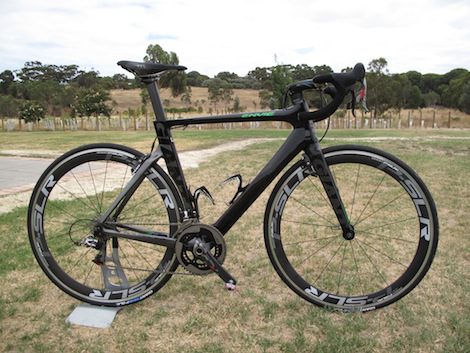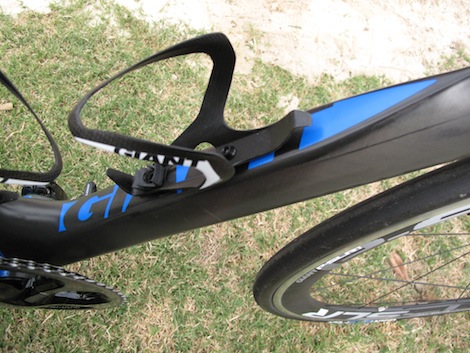Unveiled: Giant Propel Advanced SL
New entries in the aero category, including the Envie Advanced for women

After years of pursuing lighter bikes, road-going riders are discovering the importance of aerodynamics on speed. They’ve started to look to bikes with aerodynamics as their primary design consideration. In turn road, bike manufacturers have responded and the aero category has exploded recently.
Giant has entered into this market with the Propel Advanced SL, a project that went through more than two years of design work, involving hundreds of hours of computational fluid dynamics (CFD) development and multiple trips to the wind tunnel to arrive at the final production model. Jon Swanson, Giant’s Global on-road category manager and one of the lead developers behind thePropel, called it “ the most difficult and exhaustive development project he has undertaken.”
Aerodynamic development
Aerodynamic performance was the overarching design theme of the Propel. Toward that end, Giant used both CFD and numerous trips to the ACE wind tunnel in Magny-Cours, France, during its development; tools also used by other manufacturers of more recent entries into the category, such as Cervelo’s S5,Scott’s Foil and Trek’s newly revamped Madone.
Like those other bikes, Giant’s Propel was tested with a life-size mannequin aboard (a scan of former Rabobank pro rider Grischa Niermann) in order to simulate real life conditions as accurately as possible, while maintaining consistency across test runs, which isn’t possible with a real rider. Giant’s mannequin could pedal too during testing, a feature shared only by Trek. Other company’s simple use a static mannequin or no mannequin at all.
Also unique to Giant’s testing and development process is the wind speed used in the tunnel. The standard industry protocol that has emerged for tunnel testing is wind speeds of 30 miles/hour or roughly 50 km/h across a yaw sweep (wind angle) of ±15°. Giant chose to test their bikes in the tunnel at wind speed of 40km/h, a speed that Swanson argues, “is a more realistic speed for the majority of the riders. Few riders are able to sustain 50 km/h for any length of time”.

Giant also tested the Propel (as well as its competitors) with one bottle on board. In real-world scenarios, riders will always head out with at least one bottle. “It makes no sense to optimize a design without taking that in to consideration,” says Swanson.

According to Giant’s wind-tunnel testing, a rider averaging 40 km/h in a 40-km time trial will be 12 seconds slower aboard the Cervelo S5, 32 seconds slower aboard the Specialized Venge, and 36 seconds slower aboard a Scott Foil and Ridley Noah when compared to the Propel.
In addition to the bottle shroud and aerodynamic tube shaping, Giant also developed proprietary, integrated brakes that blend in to the fork and seatstays, in pursuit of minimum drag. Essentially mini V-brakes redesigned with aerodynamics in mind, the TRP-built SpeedControl SLR brakes are optimized for the leverage ratio of both Shimano Dura Ace 9000 and SRAM Red levers, adjustable for both wide and narrow rims with shapes optimized for the trailing edges of the fork and seatstays. When asked why they chose to forgo the under-chainstay mount location, Swanson explained, “it was driven by the need of the pro team (Blanco, formerly Rabobank). It was important to them that the brakes be in an accessible location for quick wheel changes. Our testing didn’t show any benefit aerodynamically to the under-chainstay location.”

Despite the aero focus, Giant also wanted the Propel to have similar weight, stiffness and handling characteristics as their benchmark race frame, the TCR Advanced SL. As a result, the Propel and TCR share identical geometry, use the same OverDrive2 1 ½” to 1 ¼”-diameter tapered steering tube, as well as the wide PowerCore BB86 bottom bracket. Giant also claims a very competitive 1675 g for a medium-size module (frame, fork, ISP clamp, brake set, headset plug). If that weight is accurate, it would put the Propel best-in-class in terms of weight, as well as stiffness-to-weight ratio, among aero road bikes.
Envie for women
Showcasing their commitment to women’s cycling, Giant also launched a women’s model, the Envie, under the Liv/Giant banner. The bike shares the same aero shaping, SpeedControl SLR brakes, OverDrive2 steerer and PowerCore BB86 bottom bracket as the men’s version. But, the Envie has a slightly lower grade of carbon, a conventionally telescoping seatpost rather than an ISP and, most important, a different range sizes with unique geometry optimized for women.

Giant’s Propel Advanced SL will be available in Canada by the end of April, and Liv/Giant Envie this fall. The Propel Advanced SL will be offered in three models: the Propel Advanced SL 0 with Shimano Dura-Ace Di2, the Propel Advanced SL 1 with mechanical Dura-Ace and the Propel Advanced SL 2 with SRAM Red. The Women’s Envie Advanced will also be available in three models: the Envie Advanced 0 will be spec’d with SRAM Red, the Envie Advanced 1 will be equipped with Shimano Ultegra and the Envie Advanced 2 with Shimano 105.
Canadian pricing is not yet available, but check back for updates on that and first ride impressions. For now, take a look at an expanded gallery. Look for an extended road test review in an upcoming issue of Canadian Cycling Magazine.
